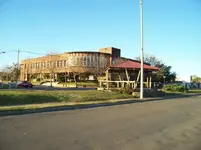ROBOTCOP13
Sr. Member
- Joined
- Jul 29, 2014
- Messages
- 301
- Reaction score
- 440
- Golden Thread
- 0
- Primary Interest:
- All Treasure Hunting
John, Andreas, Barry for a few
Na. Every coin is unique. Anyhow, you were looking for a source of money, I pointed you to one, readily available.
They cost you the price of a coffee. I always wear mine and I am a poor archaeologist.
View attachment 1852572

John, Andreas, Barry for a few
Back in the mid '80s I was delivering a 53' Van de Stadt sailboat with a girlfriend and we hung out at the hotel in Port Royal . The docks were being rebuilt by several brothers from Miami and I watched them 'wander' offshore while diving. Took awhile but eventually I was able to get their confidence and they told me they had made one trip to Miami to sell a shoebox of pieces of eight. Every coin shop they walked into the guy told them someone else had been there earlier selling the same vintage coins. His description matched one of the Texas A & M scientist that was staying at the hotel. Probably paying off his student loans instead of diving for 'science'. I've been jaded about archaeologist since then.

But like all archaeologists, he is very interested in stealing yours.
We aren't pirates.
THEY ARE PIRATES
Hey gents, at what do you put the over/under for number of shipwrecks this guy has discovered?
I am betting zero.
He doesn't find wrecks. He is incapable of finding wrecks.
But like all archaeologists, he is very interested in stealing yours.
We aren't pirates.
THEY ARE PIRATES

Here's an interesting link. You know how people like to insinuate that the United States invented African slavery in the Americas.
Guess who started it.
https://en.wikipedia.org/wiki/Atlantic_slave_trade
I used to believe that it was the Spanish with perhaps Portugese navigators but that link says it was the Portugese 100%.
I don't believe in punishing the current generations for the sins of their forefathers, that's kind of a liberal/socialist weapon to lay guilt on people but protecting Mozambique from treasure hunters, yeah that kind of makes up for it.
I don't believe in punishing the current generations for the sins of their forefathers, that's kind of a liberal/socialist weapon to lay guilt on people but protecting Mozambique from treasure hunters, yeah that kind of makes up for it.
Well, last time I counted I had searched for and found:
1) The 1782 HMS Pallas (Azores)
2) The 1878 Lidador (Azores)
3) The Angra B and D (both Spanish 16th century naos, Azores)
4) Angra C (Maybe Dutch hulk, mid 17th century, Azores)
5) The Nossa Senhora da Luz, 1615 Portuguese Eastindiaman, Azores
6) The Gomezianes, 1917, sunk by a German Uboat, Portugal mainland
7) The Portuguese Navy Roberto Ivens, sunk 1917 by a German Uboat, Portugal mainland
8) The Belinho wreck, an early 16th century Iberian ship, Portugal mainland
9) the Sao Francisco Xavier, Portuguese East Indiamen, sunk 1632, Portugal mainland
10) the Run'Her, a Confederate blockade runner, sunk 1864, Azores
I have also dove and worked in scores of Portuguese, American, Spanish and other nation's wrecks in Australia, Indonesia, Oman, Emirates, Mozambique, Cape Verde, Uruguay and Portugal. I have more than 3000 dives in archaeological context. I have picked gold and silver from the bottom of the seas, dismantled wrecks timber by timber and moved them out of harm's way, drawn stuff underwater till my fingers got numbed, raised anchors and iron cannons as well as bronze culverins from 135 feet deep, towed mags and sss from dawn to dusk, got half drown once.
I can also fluently read any archive document in French, Spanish, English and Portuguese.
But you are right - I am here to steal all your 1715 and 1733 shipwrecks, because these seem to be the only ones being discussed ad nauseam here..




I was really bored so I spent about 10 minutes researching your claims:
1782 Pallas was salvaged by locals for well over one hundred years and is a well known wreck site.
Lidador, Angra B, C and D, Nossa Senhora da Luz and RunHer are all located within the Underwater Archaeological Park of the Bay of Angra do Heroísmo!!! You did not "find" any of them. They and many others were well known, thus the creation of the park.
And the rest? The "Portugal mainland" wrecks? All found washed up on the beach!!!
